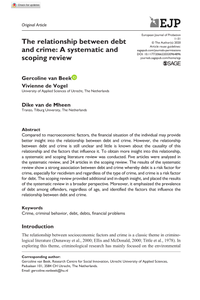Het begrip high impact crime is niet echt meegegroeid met de veranderingen in de samenleving. Hoogste tijd dus om opnieuw na te denken over wat de high impact crimes van deze tijd eigenlijk zijn. Online slutshaming hoort daar zeker bij. Die erkenning is belangrijk zodat de jonge vrouwen die het treft weten dat ze niet alleen staan.
LINK
In our highly digitalized society, cybercrime has become a common crime. However, because research into cybercriminals is in its infancy, our knowledge about cybercriminals is still limited. One of the main considerations is whether cybercriminals have higher intellectual capabilities than traditional criminals or even the general population. Although criminological studies clearly show that traditional criminals have lower intellectual capabilities, little is known about the relationship between cybercrime and intelligence. The current study adds to the literature by exploring the relationship between CITO-test scores and cybercrime in the Netherlands. The CITO final test is a standardized test for primary school students - usually taken at the age of 11 or 12 - and highly correlated with IQ-scores. Data from Statistics Netherlands were used to compare CITO-test scores of 143 apprehended cybercriminals with those of 143 apprehended traditional criminals and 143 non-criminals, matched on age, sex, and country of birth. Ordinary Least Squares regression analyses were used to compare CITO test scores between cybercriminals, traditional criminals, and non-criminals. Additionally, a discordant sibling design was used to control for unmeasured confounding by family factors. Findings reveal that cybercriminals have significantly higher CITO test scores compared to traditional criminals and significantly lower CITO test scores compared to non-criminals.
DOCUMENT

Compared to macroeconomic factors, the financial situation of the individual may provide better insight into the relationship between debt and crime. However, the relationship between debt and crime is still unclear and little is known about the causality of this relationship and the factors that influence it. To obtain more insight into this relationship, a systematic and scoping literature review was conducted. Five articles were analyzed in the systematic review, and 24 articles in the scoping review. The results of the systematic review show a strong association between debt and crime whereby debt is a risk factor for crime, especially for recidivism and regardless of the type of crime, and crime is a risk factor for debt. The scoping review provided additional and in-depth insight, and placed the results of the systematic review in a broader perspective. Moreover, it emphasized the prevalence of debt among offenders, regardless of age, and identified the factors that influence the relationship between debt and crime.
DOCUMENT

Ambtenaren openbare orde en veiligheid spelen een centrale rol in de zorg voor maatschappelijke veiligheid. Hun focus ligt van oudsher op de preventie van slachtofferschap van veelvoorkomende criminaliteit (zoals diefstal, vernielingen en vandalisme) en high impact crime (zoals woninginbraak, overvallen en straatroven) binnen hun verzorgingsgebied. Intussen heeft de digitalisering van de samenleving een ongeëvenaarde gelegenheid voor criminaliteit gecreëerd. De totale maatschappelijke schade van cybercrime werd voor 2018 op 10 miljard euro geschat (1% van BNP). Uit cijfers van het CBS blijkt dat tussen 2012 en 2018 het slachtofferschap van hacken zelfs hoger lag dan dat van fietsendiefstal. Nederlandse gemeenten hebben cybercrime in de afgelopen twee jaar dan ook breed als beleidsprioriteit omarmd. Maar in de vertaling van deze beleidsprioriteit naar concrete acties gaat het mis. Duidelijk is dat de ambtenaren openbare orde en veiligheid een taak voor zichzelf zien in de preventie van cybercrime, maar waar te beginnen? In dit project bundelen professionals uit twaalf gemeenten en vier regionale veiligheidsnetwerken hun slagkracht met onderzoekers van twee hogescholen en het NSCR voor de cyberweerbaarheid van de samenleving. De hoofdvraag van dit project luidt: Met welke interventies kunnen ambtenaren openbare orde en veiligheid de cyberweerbaarheid van burgers en bedrijven binnen hun gemeente vergroten? Middels actieonderzoek werken professionals van gemeenten en regio’s samen met onderzoekers aan het verbeteren van bestaande en het ontwikkelen van nieuwe interventies. Daarbij verscherpen zij hun beeld van de omvang en achtergronden van slachtofferschap van cybercrime. Ook onderzoeken zij achtergronden en verklaringen voor het risicobewustzijn en preventief gedrag onder doelgroepen. Deze inzichten worden in verschillende iteraties aangevuld met effectstudies, om tot een set beproefde interventies te komen waarmee de cyberweerbaarheid van burgers en bedrijven zal toenemen.